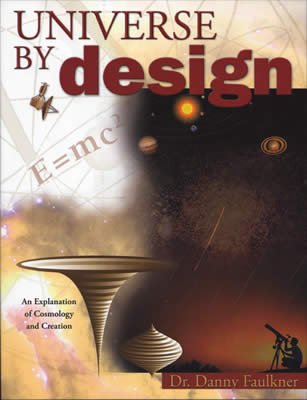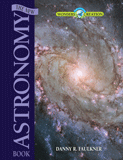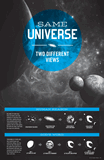
Chapter 5
Non-Biblical Alternatives to the Big Bang
What are the alternatives to the big bang, and how pervasive is the belief in the big bang?
The Steady-State Model
The steady-state theory was briefly described in chapter 1, though the theory was not discussed much there. The reason is that most cosmologists (with a few notable exceptions) discarded the steady-state model during the 1960s because of the discovery of the CBR. There are other physical problems with the steady-state theory that we have not mentioned. These include the distributions of quasars and bright radio sources. Quasars are very rare locally, with none lying within a billion light years of the earth. At great distances quasars are quite common. It is very easy to show that the local density of quasars is much less than the quasar density at great distances. This violates the assumption that the universe is homogeneous, upon which both the steady-state and the big-bang theories are based. It also would seem to suggest that we lie at an unusual location in the universe, which violates the spirit of the Copernican revolution.
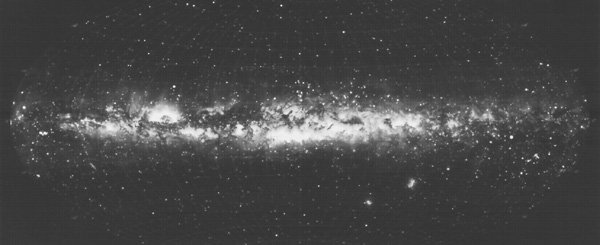
Image courtesy of NASA
Milky Way Galaxy
How can this be explained? In the big-bang model, when we look at distant objects we are looking at objects from a much earlier period in the universe. Greater distances correspond to greater look-back times. In a big-bang universe, the universe and the things in it change, or evolve, with time. So quasars must be objects that were common in the early universe but are now quite rare. However, in the steady-state model the universe as a whole does not evolve, though individual objects in the universe do so. At any given time there will be old and young objects mixed together. We would expect to see young objects such as quasars pretty much uniformly scattered among old objects across the universe. In the steady-state theory we are also looking back into time when we look at distant objects, but the things that existed at that time would not be any different from the objects that exist today. So while the big-bang model can explain the sparseness of local quasars through evolution, the steady-state theory cannot appeal to evolution. Therefore, quasar statistics do not permit a homogeneous steady-state universe.
The statistics of bright radio sources are very similar to quasars (very few locally, but many at great distances), and so the same reasoning applies to them. In addition, astronomers have found that there are systematic changes in galaxies with distance. After correcting for redshift, distant galaxies appear bluer than nearby galaxies. Astronomers interpret this as evidence of intense star formation that must have happened early in the histories of galaxies. The steady-state theory posits that all galaxies are born and die and that in any particular location at any time one would expect to see a mixture of young and old galaxies. Even if the bluer colors of distant galaxies are not due to evolution, the steady-state theory cannot explain this color difference.
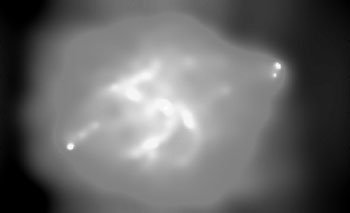
Image courtesy of NASA
Recorded by the orbiting Chandra Observatory, Cygnus A is seen here as a spectacular high-energy x-ray source. But it is actually more famous at the low-energy end of the electromagnetic spectrum as one of the brightest celestial radio sources.
In a big-bang universe, objects at great distances and in all directions would be systematically younger than nearby objects. This is true whether the universe has a center or not, because in either case all that is important is the distance from our location and how long it has taken light to travel to us.
A more basic problem with the steady-state theory is the second law of thermodynamics, the principle that energy, though conserved, is becoming less available for work. This increase in the lack of availability of energy is called entropy. The law of increasing entropy has been applied to information and complicated, well-working systems such as life. Many readers will recall its use in discussions of alleged biological evolution. It would seem that if the universe were eternal, as in the steady-state theory, then there would have been more-than-sufficient time for the universe to have reached a state of maximum entropy. This is obviously not the case. Steady-state theorists assume that as matter spontaneously appears to maintain a constant density, negative entropy is introduced to keep the entropy state of the universe at a constant as well. According to the theory we do not notice either the addition of matter or negative entropy, because both are too small to observe on a local level. It should be emphasized that neither process has been observed; so one must question them on the basis of science.
This does not mean that the steady-state theory has been totally abandoned. The philosophical appeal of an eternal universe that requires no beginning (and hence no Creator) is quite strong. At one time many of the proponents of the steady-state model insisted that it had to be true, because it was so beautiful. The best example of a steady-state theorist is the late Sir Fred Hoyle. Hoyle continued work on a version of the steady-state model that would produce the CBR, but he did not succeed. All the while, Hoyle and others who support the steady-state theory have continued writing papers that are critical of the big-bang theory.
The Plasma Universe
Given that the steady-state theory enjoys very little support today, it does not warrant much discussion in a recent creation context. Therefore in this book we assume that the big bang is the only viable cosmological theory considered by most scientists. However, in recent years a new cosmology called the plasma universe has been proposed. The best source for this is the book by Eric Lerner.1 One of the more noticeable adherents of this theory is the Nobel Prize winner, Hans Alfven. Plasma theorists point out that cosmologists generally assume that gravity is the only significant force that affects the structure of the universe, though gravity by far is the weakest of the fundamental forces. Electromagnetic forces are far stronger and are responsible for chemical bonds that cause most of the forces that we encounter every day. However, while the effect of gravity appears to have no limit over the distance that it operates, electromagnetic forces generally have a limited range. This limitation is due to the fact that most matter is electrically neutral.
Plasma theorists ask if this situation is necessarily true over all space. Is it possible that on a grand scale, electromagnetic forces may be as significant or greater than gravity? For instance, there may be some distance limitation on the pull of gravity about which we do not know. We do know that the galaxy is permeated by a magnetic field, though its measured strength appears to be so small that its effects overall are far less than those of gravity. Plasma theorists also note that the spiral structure of galaxies is very similar to the pinch effect often produced in plasmas in laboratory experiments. Persistent spiral structure has been difficult to explain in terms of gravity alone, and so plasma theorists cite spiral structure as evidence that magnetic effects significantly affect matter on a large scale.
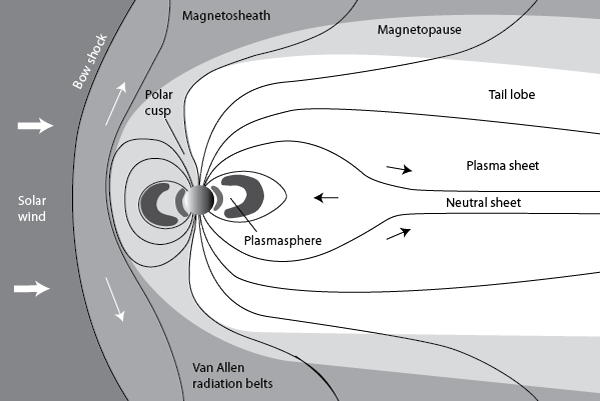
Image courtesy of Bryan Miller
The Earth’s magnetosphere
The plasma theory suggests that the universe is permeated with strong magnetic fields that confine how matter moves. If magnetic force dominates gravitational force over the large scale of the universe, then any cosmology that overlooks this is seriously flawed. In the plasma universe, magnetic force shapes local structure such as spiral galaxies and clusters of galaxies, but it also determines the structure of the universe as a whole. Plasma theorists believe that the universe is eternal and exists in a steady-state, but without the addition of mass as in the classical steady-state model.
How can this be reconciled with the observation that the universe is expanding? After all, if the universe is eternally expanding, there should have been more-than-ample time to have expanded the universe to virtually zero density. Plasma theorists reply that the universe has not always been expanding. Instead, there are regions of the universe that are now expanding, but there are others that are contracting. Expanding regions will eventually halt expansion and contract, while contracting regions will reverse and begin expanding at some time in the future. Different parts of the universe have been alternately expanding and contracting in this fashion forever and will continue to do so forever. We just happen to live in a region of space that is expanding at this time. We also must be far from any neighboring regions that are contracting, or else we would see evidence of that. In other words, our expanding universe is merely a small subset of a much larger universe, and the extrapolation of the expansion back into time to a big bang is an unwarranted extrapolation.
The lack of alternatives to the big bang is testament to how pervasive belief in the big-bang theory has become.
There are a number of problems with the plasma cosmology. It asks us to accept some things that have not been observed. It cannot explain the CBR. The originators of the plasma universe have not explained how the increase in entropy with time can be circumvented. From a Christian perspective there are problems as well. The plasma cosmology is a return to an eternal universe, so there is no need or place for a Creator. While the big-bang cosmology has attracted a number of theists because it demands that the universe have a beginning, it is difficult to imagine that the plasma cosmology has any theists among its adherents.
The lack of alternatives to the big bang is testament to how pervasive belief in the big-bang theory has become. Since the 1960s very few scientists have thought it necessary to consider any other model. As during any scientific revolution, people hold onto the ruling paradigm long after numerous problems develop. Eventually some crucial results lead to the abandonment of the paradigm. After that there is some considerable casting about for an alternative. When the big bang falls into disfavor, one can expect that there will be no theoretical foundation for a substitute. At that time there will be many alternatives offered.
Checking Your Understanding
- If quasar redshifts are cosmological, then all quasars are far away from us. Why is this a problem for the steady-state theory?
- How can the big-bang theory explain why we do not see quasars locally?
- How does the steady-state theory violate the second law of thermodynamics?
- How is the plasma universe different from other cosmological models?
Universe by Design
This book explores the universe, explaining its origins and discussing the historical development of cosmology from a creationist viewpoint.
Read Online Buy BookFootnotes
- E. Lerner, The Big Bang Never Happened (New York: Random House, 1991).
Recommended Resources

Answers in Genesis is an apologetics ministry, dedicated to helping Christians defend their faith and proclaim the good news of Jesus Christ.
- Customer Service 800.778.3390
- © 2024 Answers in Genesis

